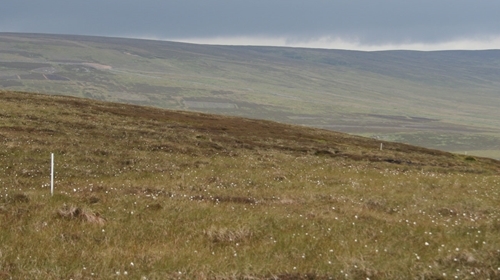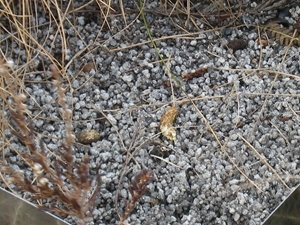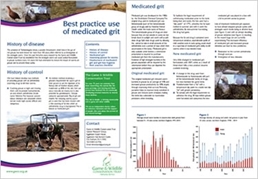Deployment
A lattice of grit sites should be established across the moor, whose frequency broadly relates to the grouse pair density in spring, i.e. a grit station in each territory. Grit sites should be either marked, using sections of alkathene pipe or small posts, or the grid reference of each grit site recorded within a handheld GPS.
 Grit boxes in this photograph are marked by posts at intervals of 100 metres.
Grit boxes in this photograph are marked by posts at intervals of 100 metres.
Grouse counts in ppring, repeated in July, give reliable estimates of pre- and post-breeding densities. By subtracting the number of grouse harvested, together with those expected to die from natural causes during the autumn/winter, from the July grouse density, this gives an approximate density in the next spring and hence the number of gritting stations required. The GWCT can assist with calculating these figures if both the count and bag data are made available to us.
Siting of grit boxes is important. Place them in short vegetation, at least 5m away from running and open water. Place stones around them to make them more obvious to grouse. With the recent occurrence of respiratory cryptosporidiosis (bulgy-eye) involving the protozoan parasite Cryptosporidium baileyi in grouse, the siting and maintenance of grit boxes has become even more important.
Grit box hygiene
 Grouse potentially spread the infective stages of cryptosporidia (oocysts) in mucous expelled from their nasal cavities and beak, as well as via both the fibrous and caecal droppings. Thus preventing contamination of grit boxes by grouse faecal material is important. Using small (20x15 cm), well-drained trays, that grouse cannot easily sit in may help to reduce contamination from faeces. Raising boxes slightly off the ground will aid drainage. Preventing the boxes holding moisture is essential because cryptosporidial oocysts require moist environments for their survival. Ultimately, the development of grit boxes more akin to poultry food pellet dispensers may be worthwhile to prevent faecal contamination. To date, we have not conducted research trials to consider whether grouse would use these types of dispensers so currently it’s just a thought.
Grouse potentially spread the infective stages of cryptosporidia (oocysts) in mucous expelled from their nasal cavities and beak, as well as via both the fibrous and caecal droppings. Thus preventing contamination of grit boxes by grouse faecal material is important. Using small (20x15 cm), well-drained trays, that grouse cannot easily sit in may help to reduce contamination from faeces. Raising boxes slightly off the ground will aid drainage. Preventing the boxes holding moisture is essential because cryptosporidial oocysts require moist environments for their survival. Ultimately, the development of grit boxes more akin to poultry food pellet dispensers may be worthwhile to prevent faecal contamination. To date, we have not conducted research trials to consider whether grouse would use these types of dispensers so currently it’s just a thought.
Regularly changing gritting station positions by only 2-3m each year may reduce accumulation of infected faeces near the tray. This may also fit with the changing availability of shorter vegetation created by burning/cutting patterns.
Medicated grit can only be placed in gritting sites and made available to grouse once shooting on the moor and adjoining neighbouring moors has finished in the autumn. It must be withdrawn from grouse at least 28 days before shooting starts. About 500g of medicated grit should be placed in each tray. A grouse consumes approximately 35g of grit per month, therefore 500g will last a pair of grouse approximately seven months.
Grit trays should be checked regularly to monitor their use on the basis of droppings being present. If time permits, remove faeces. Replenish used grit as required. Unused trays may benefit from relocation.
Only use fresh medicated grit each year. Do not place new medicated grit on the top of old. This will not only dilute the effectiveness of the anthelmintic, but it may also increase the risk of infection from cryptosporidia. Remove unused medicated grit at the end of June/early July and responsibly dispose of it using a legal waste disposal contractor. Ideally, trays should also be removed and cleaned by power washing, before re-using.
< Return to our guidelines
Get your FREE guide on best practice use of medicated grit
Simply enter your email address below to download your free guide.
 What's inside your FREE guide
What's inside your FREE guide
✓ History of disease
✓ History of control
✓ Medicated grit
✓ Assessing grouse for worms
✓ Deployment of medicated grit and grit box hygiene
✓ Best practice checklist
*You may change your mind any time. For more information, see our Privacy Policy.